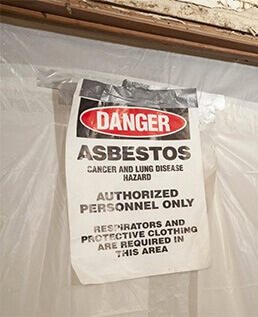Asbestos Disposal Policies in Vancouver
Posted in Asbestos Removal, on December 21, 2021
While there are measures in place that permit for a safe and easy disposal of asbestos-containing materials for homeowners within Metro Vancouver, the actual process of asbestos removal in Vancouver can be a dangerous task and it’s recommended that the procedure be carried out by a professional asbestos abatement contractor.
Homeowners disposing of abated asbestos-containing materials should seek services that provide asbestos testing in Vancouver beforehand to get an analysis of the hazards present in your material. Canada’s Restoration Services will take samples of the asbestos-containing material during an inspection and give them to a third-party laboratory, for an analysis of the material’s danger levels based on its asbestos concentration level and the type of asbestos in the product.
Regular asbestos testing in Vancouver has found that there are at least 3,000 building materials containing asbestos that were developed before the turn of the 20th century. Recurring materials in the process of asbestos removal in Vancouver includes insulation, ceiling and flooring tiles, drywall and more. Exposure to high levels of asbestos can pose a significant risk to your health, so it’s important that you know of the dangers associated with asbestos exposure during every step of asbestos removal in Vancouver from inspections all the way to cleanup and disposal.
Disposing of Abated Asbestos in Vancouver
.png) Following asbestos confirmation from an accredited laboratory and the safe removal of the material by a professional asbestos abatement contractor, residents living in the Vancouver area must be careful to choose a disposal site that accepts asbestos. For insight into effective and safe asbestos removal in the area, Canada’s Restoration Services can help.
Following asbestos confirmation from an accredited laboratory and the safe removal of the material by a professional asbestos abatement contractor, residents living in the Vancouver area must be careful to choose a disposal site that accepts asbestos. For insight into effective and safe asbestos removal in the area, Canada’s Restoration Services can help.
Because of the risks associated with the mineral, landfill and waste management sites will charge a disposal fee that ranges from a minimum of $15 to $200/per tonne. To prevent the risk exposure, the waste must be placed in double-bagged plastic, hazardous waste bags that must be a minimum of 0.15 mm or 6 mil thick (one mil is a thousandth of an inch). All bags should be labelled clearly.
Residents wishing to dispose of insulation or vermiculite materials that contain asbestos must first wet the insulation before placing the items in the aforementioned waste bags. Pipes containing asbestos must have the broken ends sealed in plastic sheets that are a minimum of 6 mil thick before double bagging the small pieces or fragments. Finally, hot water tanks lined with asbestos must be double-wrapped or sealed with plastic sheets that are also a minimum of 6 mil thick.
Any used residential drywall is accepted for disposal, as drywall installed before 1990 is at risk of containing asbestos. The drywall must be delivered to the landfill by the homeowner in a non-commercial vehicle . Be sure to have your driver’s license ready, as the source of the drywall will be recorded. The drywall must be double-bagged and sealed in plastic bags that are 6 mil thick prior to disposal, and each bag must be individually sealed and labelled “drywall”.
Consulting with Professionals For Asbestos Removal and Testing in Vancouver
As noted earlier, it’s recommended that the entire procedure of asbestos testing and removal in Vancouver be conducted by certified professionals to prevent risking your health and safety. In addition to taking samples and providing them to laboratories for testing, Canada’s Restoration Services will also set up a full containment site during the removal process. Protective equipment is used to ensure that belongings are safe from any cross-contamination, while any potentially affected material is placed in asbestos certified bags and properly disposed of. Throughout the entire process, air scrubbing machines with HEPA filtration systems remain running.
Experts will first spray the asbestos-containing material in question with a binding agent so that it remains wet as it is being removed, helping to prevent the fibres from becoming airborne. Once the plaster is removed, it’s placed in 6 mm poly bags and sealed.







